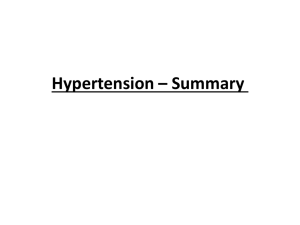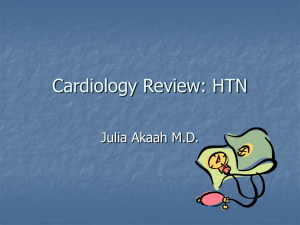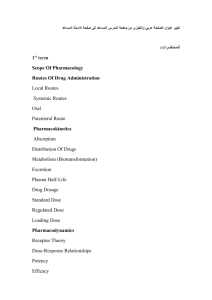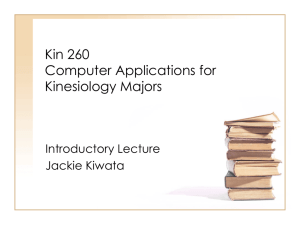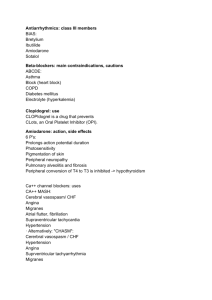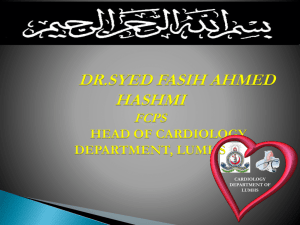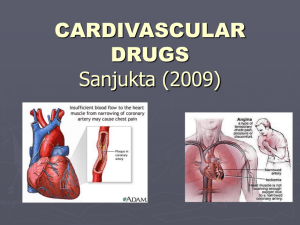MS Diagnostic Coding
advertisement
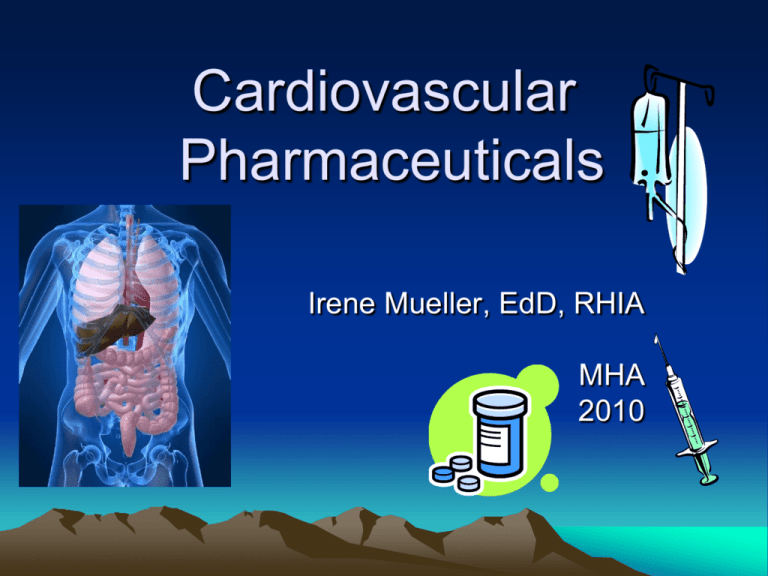
Cardiovascular Pharmaceuticals Irene Mueller, EdD, RHIA MHA 2010 Objectives – First Hour • Medications – Heart – Vessels Objectives - 2nd hour • Medications – Vessels, continued • Using the ICD-9-CM Table of Drugs • Homework Answers • Responses to Questions • Resources CV System Pharmaceuticals • Many can be used for – Multiple Heart AND/OR vessel conditions – Dosage, etc. variations – Therefore, can be grouped many ways • Many used in combination • Many can interact with – each other – Other types of meds • Following lists are most common • Many other drugs Actions of Heart Drugs • Possible actions of cardiac drugs – change the rate of the heartbeat – change the rhythm of the heartbeat – change the amount of output of blood – change the strength of contraction • Inotropic and Cardiotonic • Blood vessel/Blood drugs can help heart Classifications of Heart Drugs ACE Inhibitors* Anti-coagulants/Anti-platelets Anti-anginals# Anti-fibinolytics Beta-adrenergic Blockers Anti-hyperlipidemics Calcium channel Blockers Cardiac glycosides Nitrites and Nitrates Diuretics Anti-arrhythmic (-Dysrhythmic) agents Carbonic Anhydrase Inhibitors Beta-adrenergic Blockers (Class II) Osmotic Calcium channel Blockers (Class IV) Thiazide/Thiazide -like Potassium channel Blockers (Class III) Sodium Channel Blockers (Class I) *Italics = in vessel section #Bold = in heart section Thrombolytics Anti-anginals Contraindications Interactions Side Effects Anemia, severe alcohol Blurred vision GI disease Viagra Dry mouth Glaucoma Flushing Intracranial pressure GI - Constipation Low blood pressure Headache Hypersensitivity reaction Orthostatic hypotension Beta-adrenergic Blockers • Reverse the sympathetic system effects – Caused by exercise, mental exertions – Decrease heart rate and force of contractions – Decrease cardiac work & oxygen consumption – Often prevents myocardial ischemia and pain • Long-term mgt of angina pectoris • Can be combined with nitrates Types of CV Beta receptors • • • • Beta-1 (β1) - heart Beta (β2) - blood vessels Beta (β3) - fat cells Block the effect of norepinephrine and epinephrine at receptor sites – reduce heart rate (B1) – reduce blood pressure by dilating blood vessels (B2) NS Beta-adrenergic Blockers • Nonselective Blockers (beta 1 and 2) • • • • Labetalol (Normodyne) – HTN Nadolol (Corgard) – HTN, angina pectoris Pindolol (Visken) – HTN Propranolol (Inderal) – HTN, angina, arrhythmias, migraine • Timolol (Blocadren) – HTN, post MI Selective Beta-1 Blockers • acebutolol (Sectral) – HTN, ventricular arrhythmias • • • • atenolol (Tenormin) – HTN, angina pectoris bisoprolol (Zebeta) – HTN esmolol (Brevibloc) – SV Tachycardia metoprolol (Lopressor) – HTN, angina pect. Calcium Channel Blockers • Can be used to treat – Tachyarrhythmias, angina pectoris, HTN • Decrease calcium entry into cells with actions potentials (heart and blood vessels) • 2 effects in heart (conduction & muscle) – Decrease rate of SA node, AV conduction – Decrease force of contractions • Effect in vessels – relaxation, vasodilation Calcium Channel Blockers • verapamil (Calan, Isoptin) – AV node/SV arrhythmias, angina • diltiazem (Cardizem) – More effective as antihypertensive • nifedipine (Procardia) – Vasodilator • nicardipine (Cardene) – Vasodilation, relax coronary artery spasm • • • • • Newer amlodipene (Norvasc) bepridil (Vascor) felodipine (Plendil) Isradipine (DynaCirc) Nitrites and Nitrates • Oldest/Most frequently used antianginals • General dilation of systemic veins/arteries – Vascular smooth muscle • Ions are converted by enzymes to Nitric Oxide • Lower doses = more venous dilation Nitrites and Nitrates • Decrease preload and afterload of heart – Preload – force of venous return to heart – Afterload – arterial pressure (blood pressure) L ventricle must work against to eject blood • Reduce cardiac work/oxygen consumption • Used prophylactically and during angina • Also to tx CHF • Nitrates relieve vasospasm in coronary art. Nitrites and Nitrates • • • • amyl nitrite (Vaporole) erythrityl Tetranitrate (Cardilate) isosorbie Dinitrate (Isordil) nitroglycerin (Nitrol, Notrostat, Nitrong, Nitro-Bid, Transderm-Nitro • pentaerythritol Tetranitrate (Peritrate) Nitroglycerin • Sublingual – Almost immediate onset, but short duration – Acute anginal attacks • • • • Ointment (2%) Extended release tablets/capsules Transdermal patches IV – Emergencies/surgeries in hospital Anti-arrhythmics • 4 classes • Class 1 – Sodium channel blockers • Class 2 – Beta-adrenergic blockers – Described in anti-anginals • Class 3 – Potassium channel blockers • Class 4 – Calcium channel blockers – Described in anti-anginals Anti-arrhythmics • Dromotrophics – irregular rhythms • Chronotropics – too fast or too slow • Several ions regulate electrical system – Sodium, Potassium, Calcium • Arrhythmias disturb movement of ions – Drugs can help restore normal movement • Anti-arrhythmics do NOT cure causes Sodium Channel Blockers (Class 1) • Interfere with movement of sodium ions • Slow conduction velocity • Tx – Supraventricular tachycardias – Ventricular arrhythmias • Side effects/Contraindications – Specific to each drug Sodium Channel Blockers • • • • • quinidine (chinchona bark) procainamide (Procanbid) disopyramide (Norpace) lidocaine (Xylocaine) phenytoin (Dilantin) • Newer – flecainide (Tambocor), moricizine (Ethmozine), propafenone (Rythmol) Potassium Channel Blockers • Decrease frequency of arrhythmias • bretylium (Bretylol) – Adrenergic neuronal blocker • amiodarone (Cordarone) – Blocks alpha, beta, calcium receptors • sotalol (Betapace) – Non-selective beta blocker Other Anti-arrhythmics • quinidine sulfate (Class 1) – decreases the # of atrial muscle contractions – used to treat Afib • Pronestyl – ventricular arrhythmias w/premature contractions – Afib • Lidocaine (Xylocaine) (Class 1) – IV - prevents & controls Vfib, pt w/recent severe MI – (SE) drowsiness, disorientation, confusion, convulsions, coma Cardiac Glycosides • Derived from Digitalis plants – Oleander, Lily of valley, Cane toads • Increase force of contractions (Inotropic) – Lowers ventricular rate • w/o increasing oxygen consumption • Kidney function improves, reducing edema • Decrease heart rate and AV conduction • Increase kidney function, reduces edema Cardiac Glycosides Contraindications Interactions Side Effects Hypothyroidism Adrenergics Arrhythmias Lactation, Pregnancy Antacids Dizziness MI Anti-arrhythmics Electrolyte imbalance Impaired kidneys Diuretics GI upset Monitor Neomycin Headache High/low potassium Phenobarbital Irritability Irregular rhythm Rifampin Lethargy Slow heart rate Sulfa drugs Muscle weakness Discontinue if noted Seizures Tremors Cardiac Glycosides • • • • Digitalization, then maintenance Low potassium increases toxic effects High potassium antagonizes tx effects High calcium enhances action • Tx CHF Cardiac Glycosides • deslanoside (Cedilanid-D) IM, IV • digitoxin (Purodigin) PO, IV • digoxin (Lanoxin) PO, IV • side effects (overdose of digoxin) - nausea, vomiting, objects appear brighter, bradycardia Diuretics • Used to tx CV conditions – HTN, Edema (CHF) • Diuretic actions – Stimulate urine production • inc glomerular filtration – Decrease sodium reabsorption (diuresis) • Five major classes of Diuretics Diuretics Contraindications Interactions Side Effects Anuria Breastfeeding Cardiac glycosides Corticosteroids Anorexia Hypersensitivity reactions (skin rash) Known hypersensitivity Pregnancy Lithium Hyperuricemia NSAIDs Hypokalemia Oral hypoglycemics Hyponatremia Hypotension Nausea Ototoxicity (loop) Classes of Diuretics Carbonic anhydrase inhibitors Organic acids (Loop) Osmotic (Lumenal) (no uses) Potassium-sparing Thiazide/Thiazide-like OTC (Xanthine derivatives) Carbonic Anhydrase Inhibitors • Increase sodium and water excretion • Not used as often today • Still adjunct tx in CHF (Acetazolamide) • Also used to tx – Glaucoma – Petit mal seizures • dichlorphennamide, mathazolamide – Acute mountain sickness (Acetazolamide) Organic Acid (Loop) Diuretics • Inhibit sodium and chloride ion transport in loop of Henle • Great loss of sodium, chloride, and water – Usu. Hypochloremic alkalosis • Tx – Edema inpts resistant to thiazides – Severe peripheral and pulmonary edema – Edema of CHF Organic Acid (Loop) Diuretics • • • • bumetanite (Bumex) – CHF edema, ascites ethacrynic acid (Ederin) – CHF edema furosemide (Lasix) – CHF edema, HTN torsemide (Demadex) – CHF edema • http://media-2.web.britannica.com/eb-media/23/99423-004-BB1F574D.jpg Potassium-Sparing Diuretics • Mild diuresis • Inhibit potassium secretion in the distal convoluted tubules • Primarily adjuncts to thiazide/loop diuretics – Inhibit hypokalemia • Hyperkalemia promoted in – Impaired renal function/diabetic pts Potassium-Sparing Diuretics • amiloride (Midamor) – HTN • spironolactone (Aldactone) – HTN, Edema • spironolactone – w/thiazide (Aldactazide) – HTN, Edema • triamterene (Dyrenium) - Edema, HTN Thiazide/Thiazide-like Diuretics • Largest group • Inhibit sodium transport in the distal portion of the nephron • Intense diuresis of sodium and water • Increase excretion of chloride and potassium • Produce alkalosis and hypokalemia – Hyponatremia in elderly reported Uses of Thiazide Diuretics • Edema of any cause – immediate • Mild/moderate HTN – 4-6 weeks – Decrease blood volume – Relax smooth muscles in vessel walls Side Effects of Thiazides • Drop in blood pressure • Orthostatic hypotension • Dizziness, faint • Hypokalemia • Hyperuricemia • Hyperglycemia • Muscle spasms/cramps • • • • • • • • Glucose changes in DM Nausea Diarrhea Constipation Anorexia Headache Impotence Elevation – BUN – Creatinine Thiazide Diuretics • • • • bendroflumethiazide (Naturetin) benzthiazide (ExNa) chlorothiazide (Diuril, Diurgen) hydrochlorothiazide (Exidrix, Ezide, HydroDIURIL, Oretic) • methyclothiazide (Enduron, Aquatensin) • polythiazide (Renese) • trichlormethizade (Diurese, Metahydrin, Naqua) Thiazide-like Diruetics • • • • chlorthalidone (Hygroton) indapamide (Lozol) metalazone (Zaraxolyn) qinethazone (Hydromox) Classification of Vessel Drugs Anti-coagulants/Antiplatelets* Diuretics Aspirin (Prostaglandin Inhibitor) Carbonic Anhydrase Inhibitors Coumarins Osmotic Heparin Thiazide/Thiazide -like Thrombolytics Antifibrinolytics Vasoconstrictors Anti-hyperlipidemics Other Vasodilators Anti-hypertensives Nitrites and Nitrates ACE Inhibitors Calcium channel Blockers# Vasodilators Alpha-adrenergic Blockers Angiotensin II receptor blockers (ARBs) *Bold = in vessel section #Italics = in heart sections Anti-coagulants (Veins) • 4 stages in coagulation and clot resolution • Anti-coagulant mechanisms – Inhibit the function of preformed clotting factors (heparin - IV/SQ) – Prevent synthesis of normal clotting factors • Coumarin derivatives (PO) • Mechanisms determines onset/duration of drug effects • Used to prevent MIs Anti-coagulants Contraindications Interactions Side Effects Uncontrolled bleeding Acetaminophen, NSAIDs Bleeding (increased) Pregancy (use with caution) Alcohol Blood irregularities Anti-infectives GI disease Barbiturates Kidney disease Chloral hydrate Liver disease Estrogen Steroids anabolic and corticoThyroid drugs Tricyclic antidepressants Coumarin Derivatives • Can be PO • Warfarin sodium (Coumadin) • Vitamin K antagonist • Side effects – Hematuria, petechiae – Nausea, Diarrha, urticaria, alopecia Heparin (IV,SQ) • Used to Prevent – Venous thrombosis, esp. Pulmonary embolism – Clots prior to blood transfusion, during open heart surgery • Treat – MI – Thrombophlebitis – Stroke • Preferred anti-coagulant during pregnancy Antiplatelets (Arteries) • Suppress aggregation of platelets – Core of arterial thrombus • Low-dose aspirin - Preventative • Clopidgrogrel (Plavix) – Previous MI • Ticlopidine (Ticlid) – More expensive than aspirin, same level of tx • Dipyridamole (Persantin) Aspirin • acetylsalicylic acid • Hippocrates (460 B.C and 377 B.C) – historical records of pain relief tx – use of powder made from willow bark and leaves for headaches, pains and fevers • 1829, scientists discovered called salicin in willow plants which provide pain relief • Aspirin was patented on February 27, 1900 by Bayer Thrombolytics • Dissolve existing clots • Tx MI w/in 6 hours of symptoms onset • 5 drugs – streptokinase (streptase) – alteplase (Activase) – urokinase (Abbokinase) – reteplase (Retavase) – anistreplase (Eminase) Anti-fibrinolytics • Help form blood clots • Provide hemostasis • Vitamin K = antidote for anticoagulant overdose Anti-hyperlipidemics (Hypolipidemics) • Atherosclerotic plaques usually in large/medium arteries – Lifestyle changes first – Diet changes needed even with meds • Prophylactic tx, lifelong once begun – Reduce cholesterol and LDL Anti-hyperlipidemics Contraindications Interactions Side Effects Biliary obstruction antacids abdominal pain Elevated liver enzymes anticoagulants arrhythmias Gallbladder disease cardiac glycosides asthenia Lactation cimetidine constipation Liver disease corticosteroids dizziness Peptic ulcers cyclosporine headache Pregnancy erythromycin myalgia Renal dysfunction iron N&V sulfonylureas rash Anti-hyperlipidemics • Bile Acid sequestrants • HMG CoA Reductase Inhibitors (statins) • Nicotinic Acid • Fibric Acid Derivatives • Estrogens Anti-hyperlipidemics • cholestyramine (Questran, Prevalite) (BAS) • colestipol (Colestid) (BAS) • • • • • atorvastin (Lipitor) fluvastatin (Lescal) lovastatin (Mevacor) pravastatin (Pravachol) simvastatin (Zocor) Break Time Anti-hypertensives • Treatment usually begins with – lifestyle changes, then add – diuretic or beta blocker, then – add another med, etc. • Compliance big problem, HTN asymptomatic • ACE Inhibitors • Vasodilators – Alpha-adrenergic Blockers – Angiotensin II receptor blockers (ARBs) ACE Inhibitors • Angiotensin Converting Enzyme (ACE) – Angiotensin is a vasoconstrictor • • • • Slow formation of angiotensin II Decrease blood volume/pressure Increase renal blood flow Interfere Less with mental/physical performance = better Quality of Life = better compliance • SE – nonprod cough, loss of taste, joint pain ACE Inhibitors (PO) • • • • • benazepril (Lotensin) enalapril (Vasotec) fosinopril (Monopril) quinapril (Accupril) ramipril (Altace) • Tx - CHF Alpha-adrenergic Blockers • Alpha-adrenergics action similar to norepinephrine (smooth muscle contraction) • Major alpha organ is blood vessels • Alpha blockers effects – Vasodilation, lower blood pressure • SE – nasal congestion, orthstatic hypotension, fainting Alpha-adrenergic Blockers - PO • • • • doxazosin (Cardura) phentolamine (Regitine HCl) prazosin (Minipress) terazosin (Hytrin) • Prescribed for Adults Angiotensin II receptor blockers (ARBs) • Angiotensin II is a vasoconstrictor • ARBs have effects that are similar to angiotensin converting enzyme (ACE) inhibitors • ACE inhibitors act by preventing the formation of angiotensin II • ARBS block the binding of angiotensin II to muscles on blood vessels Angiotensin II receptor blockers (ARBs) • • • • • • • candesartan (Atacand) eprosartan (Teveten) irbesartan (Avapro) telmisartan (Micardis) valsartan (Diovan) losartan (Cozaar) olmesartan (Benicar) Vasoconstrictors • Constrict the muscle fibers in blood vessel walls by direct action on vessels OR stimulate the vasomotor center in medulla – stop superficial hemorrhage – relieve nasal congestion – Raise blood pressure – Increase force of heart Vasoconstrictors • norepinephrine (Levophed) – tx hypotension • metaraminol (Aramine) – prolonged duration, raises bl pressure • epinephrine (Adrenalin) Vasodilators • Increase size of bl vessels • Used to tx peripheral vascular disease, heart conditions (CHF), & HTN • Papaverine – opium alkaloid, but NOT narcotic • Alcohol - dilates blood vessels by depressing the vasomotor center of medulla – can tx angina pectoris? Using the Table of Drugs • Coder must determine – Adverse Effect vs Poisoning – Decision Flow chart • Taking less/stopping drug is – NOT poisoning OR adverse effect • 980 – 989 - Toxic effects of NON-medicinal substances = follow Poisoning steps Table of Drugs • Rows = Drugs, medicinal substances • Columns = Poisoning code, E codes • ALWAYS VERIFY in TL – Instructional Notes • Ex: 960 Poisoning by antibiotics – Exclusion Note: 976.x should be used for local (topical) applications Adverse Effect • Correct substance administered as prescribed • Adverse effect (manifestation) sequenced 1st • E code from Therapeutic use column 2nd • CANNOT use E code from any other column • Adverse Effect E codes MUST BE REPORTED Adverse Effect Documentation • Dx statements of – Toxic effect, toxicity, intoxication due to prescription drug (digitalis, lithium) – w/o any further info – Indicates Adverse Effect • Other terms for AE – Allergic reaction – Cumulative effect (toxicity) – Hypersensitivity – Idiosyncratic reaction – Paradoxical reaction – Synergistic reaction Adverse Effects • • • • Toxicity Synergistic reaction Side effect Idiosyncratic reaction • Because of • Pt differences – Age, sex, disease – Genetic factors • Drug-related – – – – – Type Administration route Duration of tx Dosage Bioavailability AE Drug E codes • When agent causes multiple adverse reactions, code the E code ONCE • When 2+ drugs are responsible, code individually unless there is a combo E code Unspec AE • 995.2 Unspec AE effect of drug, … – CAN be used in OUTpatient setting – Inappropriate for Inpatient setting • Code S&S or 796.0 w/ Ecode Late Effects of AE of Drugs • Code residual condition • 909.5 • E code (E930-E949) • Chronic effects of drug taken for long time and still being taken = current AE • If delayed effects AFTER stopping = LE Late Effects AE Examples • Brain damage caused by penicillin allergy (while taking med) – 348.9, E930.0 • Brain damage caused by penicillin allergy (stopped using 6 months ago) – 348.9, 909.5, E930.0 Poisoning • Substance used incorrectly – Error in prescription – Drug overdose (Intentional/Accidental) – Non-prescribed drug taken with correctly prescribed/taken drug – Wrong administration method – Wrong dosage given/taken – Wrong medication given/taken Poisoning • Code from Poisoning column first • Manifestation • E code for how substance used – Accident, Assault, Suicide, etc. • CANNOT use E code from Tx Use column Poisoning by Interaction • Tx drug and nonprescription drug or alcohol – Poisoning code for EACH substance – Manifestation, if documented – E code for EACH substance • Ex: Coma due to Adverse reaction to Valium taken correctly, but with 2 martinis • 980.0 • 969.4 • 780.01 • E860.0 • E853.2 Poisoning E codes • Cause not stated = undetermined E code Substance Abuse/Dependence • Acute condition due to alcohol/drug abuse/dependence = Poisoning code – Code acute manifestation – Code abuse/dependence – E code • Ex: Acute pulmonary edema due to accidental heroin overdose/pt dependent – 965.01, 518.4, 304.00, E850.0 • Chronic conditions are NOT poisoning Late Effects of Poisoning • • • • Same LE rules Residual coded first 909.0 E929.2 Specific Drug NOT in Table • American Hospital Formulary Service (AHFS) • Index from brand names, etc to # – Hospital Pharmacist is valuable resource • ICD-9-CM Appendix 3 has list of AHFS # by drug functions (no brand names) • May have to research drug name to find type and then find type in Appx 3 Drug Resources • Mayo Clinic – http://www.mayoclinic.com/health/druginformation/DrugHerbIndex • Medicinenet.com – http://www.medicinenet.com/medications/artic le.htm • MedlinePlus – http://www.nlm.nih.gov/medlineplus/druginfor mation.html Drug Resources • NLM. NIH. Drug Information Portal. – http://druginfo.nlm.nih.gov/drugportal/drugport al.jsp • PDRHealth. Drugs and Supplements. – http://pdrhealth.com/drugs/drugs-index.aspx Adverse Effects vs Poisoning Condition due to Drug, Med. Bio? NO Code Condition Yes Med used exactly as prescribed? NO Code as Poisoning Add code for condition Add E code (Optional) Yes Alcohol/non-prescr. drug also NO Code condition taken? Add Tx use E code (E930-E949) Yes Code as Poisoning Add code for condition Add E code (Optional) Drug Coding • Hypokalemia resulting from reaction to Diuril given by mistake in Dr’s office • Electrolyte imbalance due to interaction between lithium carbonate and Diruil, both taken as prescribed • Toxic encephalopathy due to excessive use of aspirin Drug coding • Coumandin intoxication due to accumulative effect resulting in gross hematuria • Severe bradycardia due to accidental double dose of digoxin • Lightheadedness due to interaction between Aldomet and peripheral vasodilating agent (both taken as presc.) Drug Coding • Bradycardia due to eating oleander leaves • Systemic hypocalcemia and hypodalemia due to using lye in housecleaning • Extrapyramidal disease due to attempted suicide by overdose of Thorazine six months ago http://biology.clc.uc.edu/graphics/steincarter/florida/Oleander%2002%20small.JPG ILEMten@gmail.com Resources • Beaman, N. Pharmacology Clear and Simple. 2008. Philadelphia:F. A. Davis. • Fulcher, E. M., Soto, C. D., and Fulcher, R. M. Pharmacology: Principles and applications. Saunders, 2003. • Hitner & Nagle. Basic Pharmacology. 4th ed. Glencoe,1999. Resources • ICD-9-CM Official Guidelines for Coding and Reporting, October 1, 2009 – http://www.cdc.gov/nchs/data/icd9/icdguide09.pdf • Inotropic and Cardiotonic Drugs. Heart Rhythm Society. – http://www.hrsonline.org/PatientInfo/Treatments/Medications/HF Drugs/ • Kapitanyan, Su, & Landry. 2009. Plant Poisoning, Glycosides – Cardiac. – http://emedicine.medscape.com/article/816781-overview Resources • Klabunde, R. Cardiovascular pharmacology concepts. – http://www.cvpharmacology.com/index.html • Medicinenet. Angiotensin II Receptor Blockers (ARBs). 2010. – http://www.medicinenet.com/angiotensin_ii_receptor_blockers/article.htm • WebMD. Heart Disease Medications. – http://www.webmd.com/heart-disease/guide/heartdisease-medications-index
